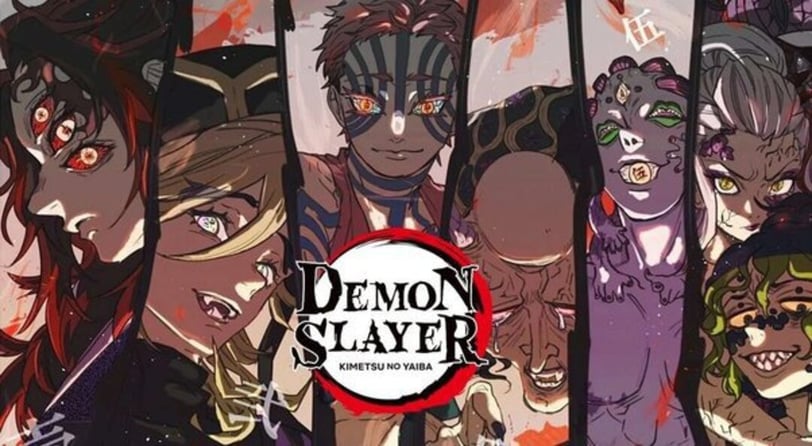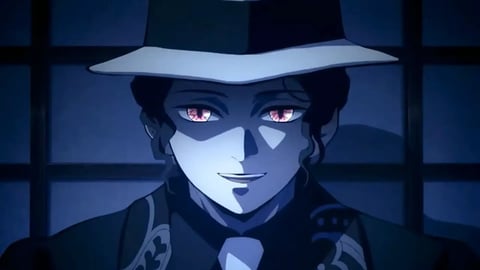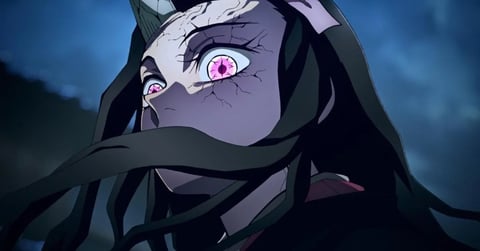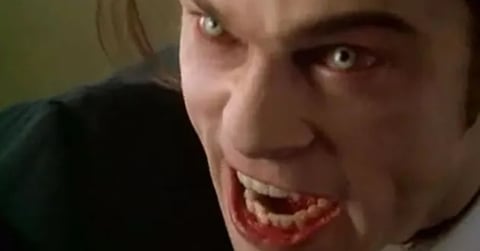Can Demon Slayer Demons Reproduce? The Truth Revealed!
Unravel the mystery of demon reproduction in Demon Slayer! Explore the biological, mythological, and symbolic aspects of their existence to uncover the secrets behind their creation and limits. Click to learn more!
DEMON SLAYER
Anime Fever
8/8/20248 min read


Demon Slayer: Kimetsu no Yaiba has captivated audiences with its intense action, beautiful animation, and richly developed characters. One of the most fascinating aspects of the series is its unique portrayal of demons—once-human beings transformed by Muzan Kibutsuji's blood into powerful, monstrous entities. These demons possess incredible abilities, yet they are also cursed with an insatiable hunger for human flesh. A question that often arises among fans is whether these demons, despite their supernatural nature, can reproduce. This article delves into the biology, mythology, and symbolism of demons in Demon Slayer to answer this intriguing question.
Understanding Demon Creation and Transformation
Before exploring the concept of demon reproduction, it's essential to understand how demons are created in the world of Demon Slayer. Muzan Kibutsuji, the first and most powerful demon, is the progenitor of all other demons. By infusing his blood into a human, Muzan can transform them into a demon. This process is both biological and mystical, altering the individual's body, mind, and spirit.
The Role of Muzan Kibutsuji
Muzan's blood is the key to demon creation. It carries his essence, which fundamentally rewrites the biology of the recipient. This transformation grants the new demon immense strength, regenerative abilities, and a hunger for human flesh. However, the process is not entirely reliable—some humans may die from the infusion, while others might not become demons at all. The strength and abilities of the demon are often proportional to the amount of Muzan's blood they receive.
This method of demon creation is unique in that it bypasses traditional reproductive processes. Demons are not born; they are made through a deliberate act of transformation by Muzan or, in rare cases, by another powerful demon who can share their blood.
The Biology of Demons: Are They Capable of Reproduction?


To address whether demons can reproduce, we must first examine their biology. The transformation from human to demon fundamentally changes their physical and physiological characteristics.
Regeneration and Immortality
One of the most notable traits of demons is their ability to regenerate. Demons can recover from nearly any injury, even regrowing lost limbs or surviving decapitation if not done with a Nichirin blade or under specific conditions. This regenerative ability is tied to their immortality—demons do not age and can live indefinitely unless killed by a specific set of circumstances.
The focus of a demon's biology is on survival and regeneration, which are essential for their existence as predators. This regenerative capability, however, does not seem to extend to reproductive functions. Unlike humans, whose bodies are designed to reproduce and continue their species, demons are solitary creatures with no biological need to reproduce.
Lack of Sexual Reproduction
There is no evidence in Demon Slayer that demons engage in sexual reproduction. The series does not depict any instances of demons mating, bearing children, or otherwise reproducing in a manner similar to humans or animals. This absence is telling—if demons were capable of reproduction, it would likely be a significant aspect of the lore, given the series' detailed exploration of their nature.
The lack of reproductive organs or functions in demons could be a consequence of their transformation. The process of becoming a demon is so all-encompassing that it rewrites their biology to focus solely on survival, strength, and the consumption of human flesh. In this new form, reproduction is unnecessary, as demons propagate through transformation rather than birth.
Demons and Human Emotions
Despite losing many human traits, some demons retain certain emotions and memories from their human lives. These lingering feelings can sometimes manifest in desires or behaviors reminiscent of their former selves. However, these emotions do not translate into a biological imperative to reproduce. Instead, they are often twisted by the demon's new nature, leading to destructive or obsessive behaviors rather than the nurturing instincts associated with reproduction.
The Role of Muzan Kibutsuji: A One-Man Lineage


Muzan Kibutsuji's role in the creation of demons is central to understanding why demons do not reproduce. As the original demon, Muzan has absolute control over his creations. He alone decides who becomes a demon, and he maintains a psychic link with those he transforms, ensuring their loyalty and dependence on him.
Control and Manipulation
Muzan's need for control is a key factor in why demons do not reproduce. If demons could independently create new demons through reproduction, it would diminish Muzan's power and influence. By being the sole source of new demons, Muzan ensures that all demons are directly connected to him, both biologically and psychologically. This control allows him to maintain his dominance over the demon world and prevent any potential threats to his authority.
The Curse of Muzan
Muzan's control over demons extends to a curse that prevents them from speaking his name or betraying him. This curse further reinforces the idea that demons are not independent beings capable of creating their own lineage. They are bound to Muzan in every way, from their creation to their ultimate fate. This curse also highlights the tragic nature of demons—they are not free beings, but rather extensions of Muzan's will, unable to escape his influence.
Symbolism and Themes: Reproduction as a Human Trait
Demon Slayer is rich in symbolism, and the absence of demon reproduction can be interpreted through the series' exploration of humanity and monstrosity.
Humanity and the Cycle of Life
In Demon Slayer, reproduction is portrayed as a distinctly human trait, tied to the cycle of life and the continuation of the species. The series often emphasizes the importance of family, heritage, and the bonds between generations. Characters like Tanjiro Kamado are driven by a deep sense of familial duty and a desire to protect future generations.
Demons, on the other hand, are cut off from this cycle. Their inability to reproduce symbolizes their severance from humanity and the natural order. They are stagnant, unchanging beings who do not contribute to the continuation of life but instead exist in a state of perpetual hunger and destruction. This lack of reproduction underscores the tragedy of their existence—they are beings without a future, doomed to an endless present of violence and isolation.
The Tragedy of Lost Humanity
The demons' inability to reproduce can also be seen as a reflection of their lost humanity. Many demons in the series retain memories of their human lives, often filled with longing and regret. These memories are a painful reminder of what they have lost—the ability to love, to nurture, and to create life. In this sense, the absence of reproduction is not just a biological limitation, but a symbol of the demons' complete transformation from human to monster.
Exceptions and Unique Cases: Exploring the Gray Areas


While the general rule is that demons cannot reproduce, Demon Slayer is a series filled with exceptions and unique cases that challenge established norms. It is worth exploring whether there are any potential loopholes or special circumstances that could allow for demon reproduction.
Nezuko Kamado: The Exception to Many Rules
Nezuko Kamado, the sister of Tanjiro, is a unique case in the Demon Slayer universe. Unlike most demons, Nezuko retains much of her humanity and does not consume human flesh. Instead, she regenerates her energy through sleep. Nezuko's ability to resist her demonic urges and maintain her sense of self suggests that not all demons are entirely severed from their human nature.
However, even in Nezuko's case, there is no indication that she retains the ability to reproduce. Her transformation into a demon, while incomplete compared to others, still altered her physiology to the point where traditional human reproductive functions are unlikely to be preserved. Nezuko's unique condition highlights the variability in demon transformations but does not provide evidence of reproductive capability.
The Upper Moon Demons: Powerful Yet Barren
The Upper Moon demons, who are the most powerful under Muzan's command, are further examples of demons who have transcended much of their human nature. These demons have achieved immense strength and abilities, often at the cost of their remaining humanity. Despite their power, there is no indication that they can reproduce.
These demons, like Akaza and Doma, are focused entirely on their strength, loyalty to Muzan, and their insatiable hunger for human flesh. Reproduction, if it were possible, would likely be a distraction from their primary goals. The Upper Moon demons represent the pinnacle of demon evolution, yet they remain barren and disconnected from the natural cycle of life.
Mythological and Folkloric Influences


The concept of demons or supernatural beings who cannot reproduce is not unique to Demon Slayer. Many myths and folklore from around the world feature creatures that are sterile, cursed, or otherwise incapable of creating life.
Oni in Japanese Folklore
The demons in Demon Slayer share many characteristics with the Oni of Japanese folklore. Oni are often depicted as malevolent beings who are powerful and destructive but not associated with reproduction. Instead, they are often seen as symbols of chaos and destruction, forces that disrupt the natural order rather than contribute to it.
In some stories, Oni are former humans who have become demons due to their evil deeds or after being corrupted by other demons. This transformation is often irreversible, with the Oni losing all ties to their former human lives, including the ability to reproduce. This mirrors the demons in Demon Slayer, who, once transformed, are severed from their humanity and the natural cycle of life.
Western Vampire Lore
There are also parallels between the demons in Demon Slayer and the Western concept of vampires. Like demons, vampires are undead beings who sustain themselves by consuming the life force of the living, often through blood. Vampires are typically portrayed as sterile, unable to reproduce through traditional means. Instead, they create new vampires by turning humans through a bite or blood exchange.
This method of propagation is similar to how demons are created in Demon Slayer, with Muzan's blood serving as the catalyst for transformation. The sterility of vampires, like that of demons, reinforces their otherness and their separation from the living world. They are creatures of death and decay, unable to participate in the creation of new life.
Conclusion
After a thorough examination of the biology, mythology, and symbolism surrounding demons in Demon Slayer, the conclusion is clear: demons cannot reproduce. Their transformation into demons fundamentally alters their physiology, focusing their biology on survival, regeneration, and the consumption of human flesh rather than reproduction.
Muzan Kibutsuji's control over demon creation ensures that all demons are directly connected to him, preventing any possibility of independent demon reproduction. This lack of reproductive capability is not just a biological limitation but a symbol of the demons' severance from humanity and the natural order.
The absence of reproduction among demons emphasizes their tragic existence—they are beings without a future, doomed to an endless cycle of hunger and destruction. They are not part of the cycle of life but are instead forces of death and chaos, existing outside the natural world.
In the world of Demon Slayer, reproduction is a uniquely human trait, tied to the themes of family, heritage, and the continuation of life. Demons, having lost their humanity, are cut off from this cycle, existing as solitary predators in a world that they cannot truly belong to.
This exploration into the question of demon reproduction not only provides a deeper understanding of these creatures but also enriches our appreciation of the series' themes and symbolism. Whether you're a long-time fan or new to the world of Demon Slayer, the complexities of demon biology and mythology offer much to ponder and discuss.
